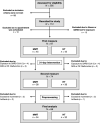Mindfulness meditation modulates stress-eating and its neural correlates
- PMID: 38538663
- PMCID: PMC10973375
- DOI: 10.1038/s41598-024-57687-7
Mindfulness meditation modulates stress-eating and its neural correlates
Abstract
Stress-related overeating can lead to excessive weight gain, increasing the risk of metabolic and cardiovascular disease. Mindfulness meditation has been demonstrated to reduce stress and increase interoceptive awareness and could, therefore, be an effective intervention for stress-related overeating behavior. To investigate the effects of mindfulness meditation on stress-eating behavior, meditation-naïve individuals with a tendency to stress-eat (N = 66) participated in either a 31-day, web-based mindfulness meditation training or a health training condition. Behavioral and resting-state fMRI data were acquired before and after the intervention. Mindfulness meditation training, in comparison to health training, was found to significantly increase mindfulness while simultaneously reducing stress- and emotional-eating tendencies as well as food cravings. These behavioral results were accompanied by functional connectivity changes between the hypothalamus, reward regions, and several areas of the default mode network in addition to changes observed between the insula and somatosensory areas. Additional changes between seed regions (i.e., hypothalamus and insula) and brain areas attributed to emotion regulation, awareness, attention, and sensory integration were observed. Notably, these changes in functional connectivity correlated with behavioral changes, thereby providing insight into the underlying neural mechanisms of the effects of mindfulness on stress-eating.Clinical trial on the ISRCTN registry: trial ID ISRCTN12901054.
Keywords: Mindfulness, Stress, Eating-Behavior, fMRI, Resting state functional connectivity.
© 2024. The Author(s).
Conflict of interest statement
This study was supported by the German Ministry for Education and Research (BMBF) grant to author KK (BMBF 01EA1807H), and the preparation of this paper was supported by the
Figures




References
Publication types
MeSH terms
Associated data
Grants and funding
LinkOut - more resources
Full Text Sources

